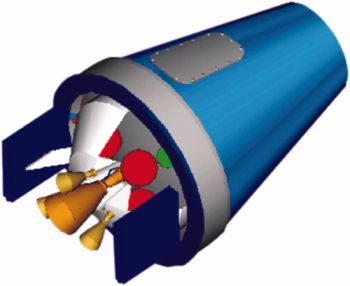--------------------------------------------------------------------------------
China will launch its third manned spacecraft Shenzhou-7 from Jiuquan Satellite Launch Center in Gansu Province in the northwest on Thursday, a spokesperson with China's manned space program said on Wednesday.
The spacecraft, carrying astronauts Zhai Zhigang, Liu Boming and Jing Haipeng, was to blast off between 9:07 p.m. and 10:27 p.m. (Beijing Time), said Wang Zhaoyao.
One of the major tasks of the mission would be extravehicular activity (EVA), or known as space walk, the first of its kind attempted by Chinese astronauts, Wang said.
The success of the task will mark a remarkable step in space exploration for China, whose long-term target is to eventually set up a space station.
Other tasks included the release of a small monitoring satellite and trials of satellite data relay, said Wang, also deputy director of China's manned space program office.
Two astronauts would enter the orbital module, where they would put on EVA spacesuits and prepare for the extravehicular activities. One astronaut would be donned with Chinese-made Feitian EVA suit and the other with a Russian Orlan suit.
"One astronaut will get out of the cabin and take back the test samples loaded outside the module," he said.
"After the EVA is completed, the spacecraft will release a small monitoring satellite. A trial of the data relay of satellite Tianlian-I will also be carried out," Wang said.
The Shenzhou-7 will be launched on a Long March II-F carrier rocket and then moved into orbit at an altitude of 343 kilometers.
At 4:00 p.m. Wednesday, engineers started to load fuel into the carrier rocket. The loading, which would last for seven hours, meant that the launch is irreversible, sources with the launch center said.
Compared with the previous two manned space missions, the Shenzhou-7 faced unprecedented technical difficulties, the official said.
"EVA is a big leap for the manned space program," he said. China had made a series of technical breakthroughs, including the research and development of an EVA suit and airlock module.
Chen Shanguang, commander-in-chief of the astronaut system, told Xinhua news agency that the China-made EVA spacesuit costs 30 million yuan (US$4.40 million) and can be worn by astronauts of 160 cm to 180 cm high.
The most complicated, advanced and expensive suit in the world, the EVA spacesuit provides a pressurized atmosphere, oxygen and temperature control for the astronauts. It also protects astronauts from radiation, micrometeoroids and other harmful particles in space. It also allows astronauts to communicate with others.
Chen said China spent less than four years in developing the EVA spacesuit and its design and assembling were done by Chinese scientists independently.
During the mission, astronauts would need to assemble and test the EVA suits, depressurize and repressurize the cabin, exit and re-enter the orbital module.
"The process of extravehicular activities cannot be simulated completely on the ground and some of the newly developed products are to be tested in flight for the first time," Wang said.
"The capability and skills of the astronauts and the quality of their operations directly determine the result of the mission," Wang said.
To ensure full-time monitoring during the EVA stage, China has added more ground monitoring stations and mobilized nine tracking ships and 30 planes. "The number of systems involved in the mission is unprecedented," Wang said.
The Shenzhou-7 crew had finished their last rehearsal and a final check of the spacecraft, rocket and ground observation and control system had been completed.
The three astronauts met the press at the launch center at 5:30 p.m. on Wednesday.
The Shenzhou-7 is scheduled to land in the central area of Inner Mongolia Autonomous Region in northern China after its mission is completed.
In 2003, China became the third country after the United States and Russia to send a human into orbit. It followed with a two-man mission in 2005.
Founded in 1958, the Jiuquan Satellite Launch Center is located in the arid Jiuquan City, Gansu Province, and is China's oldest satellite launch center. The center is used to launch scientific experimental satellites and retrievable satellites at lower, medium-range and higher orbits.

The launch tower of Shenzhou VII, China's third manned space mission bathed in the morning sunlight.

(L-R) Jing Haipeng, Zhai Zhigang and Liu Boming, the three astronauts set to complete China's third manned space mission, meet with the press on September 24, 2008. [Photo: Xinhuanet]
The Shenzhou-7 spaceship will carry Zhai Zhigang, Liu Boming and Jing Haipeng, all aged 42, for China's third manned space mission that will include the country's first ever space walk.
Zhai Zhigang, born in October 1966 in Longjiang County, Heilongjiang Province, enrolled at the People's Liberation Army Air Force in 1985. He had 950 hours of safe flight time as a fighter pilot. Zhai become one of the first group of Chinese astronauts in January 1998.
Zhai was one of three astronauts who were part of the final group to train for the Shenzhou-5 flight in 2003. Yang Liwei was picked for the flight, with Zhai Zhigang ranked second ahead of Nie Haisheng. Zhai was also one of the six astronauts in the final training for Shenzhou-6 mission in 2005 during which Fei Junlong and Nie Haisheng flew the flight.
Liu Boming was born in Yi'an County, Heilongjiang Province, in September 1966. Liu joined the People's Liberation Army in 1985 and has clocked 1,050 hours of safe flight time. Also selected to be one of the first group of Chinese astronauts in January 1998, Liu was one of the six astronauts in the final training for Shenzhou-6 mission in 2005.
Jing Haipeng was born in October 1966, in Yuncheng city, Shanxi Province. He joined the People's Liberation Army in 1985 and has clocked 1,200 hours of safe flight time. Jing was also selected to be one of the first group of Chinese astronauts in January 1998. He was among the six trainees in for the Shenzhou-6 mission in 2005.



